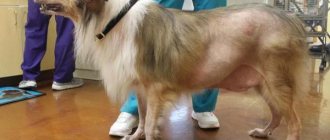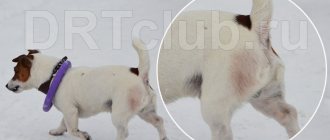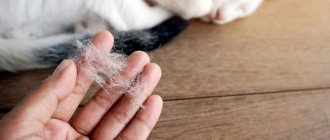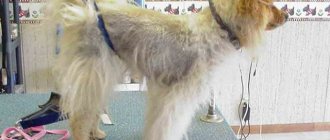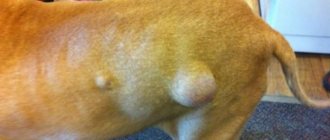Coat is an indicator of a dog's health. When the fur comes out in clumps, the pet takes on an unkempt appearance, bald patches appear, and the root cause of the hair loss must be urgently identified.
In this article I will talk about the main reasons for accelerated hair loss in dogs. I will recommend diet therapy tools that you can use to solve the problem yourself. In what cases is veterinary care necessary?
If you have already identified the reason, go to the “What to do” section. There is a step-by-step plan for combating the disease.
Examples:
Why does my dog itch and lose hair?
The pathology is called alopecia, and can occur in both small breeds and German shepherds. The biggest concern arises if the dog itself is very fluffy, so pieces of fur can be found at home on the carpet or upholstered furniture, which causes a lot of inconvenience. After all, you have to often clean the paths and comb the dogs so that the hair is not on almost all of the owners’ clothes.
Why does a dog itch and hair fall out?
- Very often, along with hair loss, there may be other symptoms that worry the dog. The main reason is hormonal imbalance. Among them, hypothyroidism can be distinguished. This is a disease of the thyroid gland that affects fairly dense overweight dogs, as well as older pets. It is worth noting that hypothyroidism mainly affects breeds such as cocker spaniel, Doberman, dachshund and retriever. In this case, the dog’s hair falls out not in any specific area, but almost over the entire surface. Along with hair loss in hypothyroidism, the pulse slows down, and darkening or lightening of the skin under the hair may be observed. The disease is treated with hormones.
- Allergy . Please note that most often it is related to food; food may not be suitable. Therefore, the wool falls out in pieces, whole clumps. Itching and rashes may occur in these areas. Please note that if this is a food allergy, you may also experience problems with stool, watery eyes and signs of conjunctivitis. Just like in humans, allergies in dogs are treated by administering antihistamines. Wounds are smeared with healing ointments, and glucocorticosteroids may be prescribed. Antibiotics are prescribed only if there is a secondary infection.
Bald patches
Allergy
A specific allergic reaction in a pet may occur in response to the penetration of a foreign protein contained in dust, mold, pollen of flowering plants and other potential allergens. A common allergy in pets is food allergy, which occurs as a response of the body to protein components of meat, eggs, fish or plants (for example, wheat).
Any allergy is accompanied by itching of the skin, flaking and anxiety. With an allergy to flea bites, the autoimmune reaction is characterized not only by itching and severe anxiety, but also by a number of other symptoms. Redness on the skin, wounds and crusts, peeling and alopecia may appear. Scabies mites can trigger allergies. Therefore, it is very important to carry out antiparasitic treatment in a timely manner.
Why does a dog lose hair on its back?
If the hair grows normally in other areas, and bald patches are observed on the back, the following ailments should be suspected.
Why does a dog lose hair on its back?
- Pituitary dwarfism. This is a deficiency of growth hormone, it is quite rare and most often among German shepherds. With this disease, hair does not fall out everywhere, but only on the tummy and back. However, with a lack of growth hormone, you can notice that the dog’s growth stops at 3-4 months, teeth do not grow and the skin is very thin and covered with dermatitis. It is also treated by administering hormones.
- Cushing's syndrome. This is a pathology in the kidney area, since the hormone cortisol is produced in the adrenal glands. At the same time, along with hair loss, the dog drinks a lot, often asks to go to the toilet in a small way, and may not behave quite adequately. Under the fur on the skin there are cracks, inflammation, and ulcers. Boxers and dachshunds are susceptible to this disease. It is also treated with hormones.
Bald patches on the back
Why does a dog lose hair?
Hormones are not the only reason why dogs may lose hair. The reasons can be very trivial, including stress. This is usually due to a change of place of residence, the death of the owner or his departure to another family.
At the same time, the dog looks lifeless, he has apathy, depression, there is no reason for joy, or, on the contrary, he is overly excited, behaves inappropriately, jumps on strangers. Along with hair loss, the dog can chew completely inedible foods, the owners sometimes find excrement in the wrong places, as well as puddles, despite the fact that before this the dog always asked to go outside and did not shit in the house.
Why does a dog lose hair?
- Hyperestrogenism . This is an excess of estrogen, which occurs not only in females, but also in males. Hair falls out mainly not over the entire surface of the body, but on the sides and on the stomach. In females, you can find swelling of the loop and nipples, regardless of the period of estrus. Treated with surgery or hormone therapy.
- Lack of estrogen production is a reverse disease that occurs mainly in females suffering from gynecological diseases. Usually found among bitches that have not been mated. In this case, the hair falls out in the groin area, that is, the loop. The skin becomes very soft and dermatitis may appear.
Bald patches
General information
Dermatitis is an acute inflammatory process of the skin , caused by various unfavorable factors, such as allergies, pathogens, stress, burns , etc. The most common signs of this disease are rash, itching, redness, blisters and crusts. In general, weeping dermatitis develops in the same way, but in the process the affected area begins to ooze ichor or exudate.
It gets wet, which creates excellent conditions for the development of pathogenic and conditionally pathogenic microflora. That is why almost all cases of weeping dermatitis are accompanied by the appearance of an unpleasant and even disgusting odor , as well as symptoms of general intoxication.
Why can a dog lose hair in patches?
Typically, domestic dogs are often free of fleas due to the fact that the owners use special shampoos. But an accidental introduction of parasites may occur if the dog walked on the street and came into contact with stray dogs.
Why a dog may lose hair in patches:
- It is worth noting that infection with parasites immediately affects the condition of the coat, it becomes dull, lacks shine, and may fall out in shreds.
- In general, when a dog is heavily infested with parasites, the dog has no hair on its hips and in the area near its tail.
- In addition, in areas where there is no fur, the skin is covered with bites and ulcers. Please note that parasites are not only fleas and lice eaters, but also worms.
- In this case, along with hair loss, the dog may experience diarrhea, constipation or vomiting. Please note that excrement or vomit may contain worms and worms.
Hair falls out
Clinical picture
The symptoms of weeping dermatitis and the distinctive symptoms of the disease are simple: itching, swelling, redness, burning, peeling, roughening of the skin and covering it with crusts, blisters, blisters. With the disease we are describing, the latter have an unpleasant habit of opening, after which ichor begins to ooze abundantly onto the surface of the skin.
Dermatitis can also have its own complications, for example, secondary infections can develop, scars subsequently appear and the pigmentation of the skin can change greatly. All this is important for owners of dogs that have high breeding value and constantly participate in exhibitions.
Why does a dog lose hair near its eye?
Fungal infections also cause hair loss. These include all types of lichen, such as microsporia or ringworm. Along with hair loss, the skin in areas becomes inflamed and peels, and wound ulcers may appear.
The wool becomes brittle and may fall out in entire tangles. Most often, puppies under one year of age suffer from fungal infections. It is treated by administering antibacterial and antifungal agents, and also do not forget to vaccinate dogs against fungal infections.
Why does a dog lose hair near its eye?
- Bacterial diseases . Oddly enough, but dermatitis occurs not only in people, but also in dogs. This could be pyoderma, ulcers, papules. Hair falls out in these places. For bacterial infections, antibiotics and antifungals are prescribed, as well as antiseptics, which are used to treat the affected areas.
- Lack of vitamins. Wool can fall out mainly in the spring, when the dog lacks vitamins. Typically, baldness occurs due to a lack of vitamin A, b2, b6, and b12. With a lack of these substances, hair does not fall out everywhere, but on the neck, muzzle, and paws. The mucous membranes may become light, and body temperature decreases. The problem is treated by administering vitamins in the form of injections, or by giving special medications that are mixed into food. It is also necessary during this period to give dogs food rich in vitamins, or introduce them separately into food.
Bald patches on a dog
Other diseases
Itching, inflammation and hair loss can be just some of the symptoms of the underlying disease, and “treating the skin” in these cases is useless. Autoimmune, endocrine, psychogenic, and malnutrition-related ailments are treated comprehensively. Therefore, do not be surprised if, in addition to examining the skin, the doctor prescribes other tests for your pet. Be prepared to answer questions about feeding and keeping the dog, about medications and behavioral characteristics, and about the health of its parents and littermates. The more questions a doctor has, the more carefully he approaches his professional responsibilities. Perhaps as a result, your animal will be prescribed treatment that is completely unrelated to skin treatment. And do not try to select medications on the Internet or by consulting with familiar dog lovers. Anti-lichen remedies will not help with skin itching of psychogenic origin, and anti-scabies ointment will not help with endocrine pathology. Entrust the diagnosis and treatment to a professional so as not to complicate your dog’s illness with negative consequences from ill-considered use of medications.
My dog has dandruff and hair loss - what should I do?
Adenitis of the sebaceous glands. This disease is rare and mainly occurs in puppies that do not reach sexual maturity. Usually hair falls out in the ear area, on the head and back. In this case, there may be a coating on the fur, and in general the hairs look stuck together and greasy. Corticosteroids and vitamins are used to treat the disease.
Your dog has dandruff and hair loss, what to do:
- What to do if your dog's hair is falling out? In this case, most owners tend to visit the pharmacy and buy a whole bag of various medicated shampoos to improve the condition of the coat. Such therapy not only does not produce results, but can also worsen the condition of the coat.
- There are a huge number of causes of hair loss, and a specialist is not always able to accurately determine the disease that a pet is suffering from the first time. Therefore, we still recommend that you consult a doctor and undergo diagnostics.
- The owner can independently determine only the presence of fleas, and only if there are a lot of them. In other cases, such as food allergies or hormonal imbalance, it is quite difficult to determine the causes on your own.
No wool
Diagnosis and treatment methods in a veterinary clinic
Only a veterinarian can make a final diagnosis for your pet after conducting a series of studies. These may include:
- taking anamnesis;
- visual inspection;
- Wood's lamp diagnostics;
- clinical analysis and blood biochemistry;
- hormone research;
- skin scraping;
- biopsy;
- stool and urine samples as additional diagnostic methods.
Depending on the diagnosis, the four-legged patient will be prescribed complex therapy. As a rule, it may include one or more appointments:
- nutrition correction;
- special vitamins for wool;
- drugs for symptomatic treatment;
- remedies for fleas and other parasites;
- antibiotics;
- anti-inflammatory drugs;
- hormone therapy;
- antihistamines;
- treatment of affected areas with special ointments, solutions, shampoos.
How to treat if your dog is losing hair?
To do this, you need to additionally take hormone tests and undergo an examination. The hair will stop falling out only if you eliminate the cause of the disease and can eliminate it.
How to treat if your dog is losing hair:
- Of course, if you recently changed the food, or switched the dog to a natural diet, then it makes sense to suspect an allergy or helminthic infestation. However, experienced dog owners usually carry out anthelmintic therapy once every 3 months, so worms are excluded.
- Also, if you have vaccinations, you can cross off certain ailments from the list, such as lichen and some others, against which vaccinations are given. In other cases, consultation with a veterinarian is necessary.
- In stressful situations, dogs are often prescribed sedatives. This usually happens during a move, or a change of place of residence, or a change in family composition. Perhaps a new member has appeared in the family, so the dog is not used to it and is stressed about it. In this case, herbal decoctions and sedatives are usually given. Most often they are sold in drops.
No fur
Diseases that are associated with a deficiency or excess of hormones cannot be identified by owners without testing. Under no circumstances should you be given hormonal medications that are not prescribed by a doctor. They can promote the growth of tumors, or even cause the death of your pet.
Therapeutic techniques
Let us immediately describe the main provisions of all therapeutic methods actively used in the treatment of this disease:
- It is necessary to completely get rid of the irritating factor and protect the pet from the action of the identified allergen (only a doctor can determine it in an equipped clinic).
- Treatment of damaged dermatitis with chlorhexidine. This is a good and inexpensive antiseptic that will help prevent bacterial contamination.
- The use of antibacterial drugs, of which the most accessible to the “mere mortal” is the usual chloramphenicol.
- To relieve skin itching, it is necessary to use antihistamines. If the dog is completely unbearable, the pet is literally tearing the skin, you can use half a tablet of Suprastin. But it’s better to take your pet to the vet right away.
- Nutritional adjustments are required. Again, we strongly advise you to talk to your veterinarian for this.
- If there is a sharp deterioration in the condition of the skin, it is necessary to urgently contact a veterinary dermatologist or allergist.


